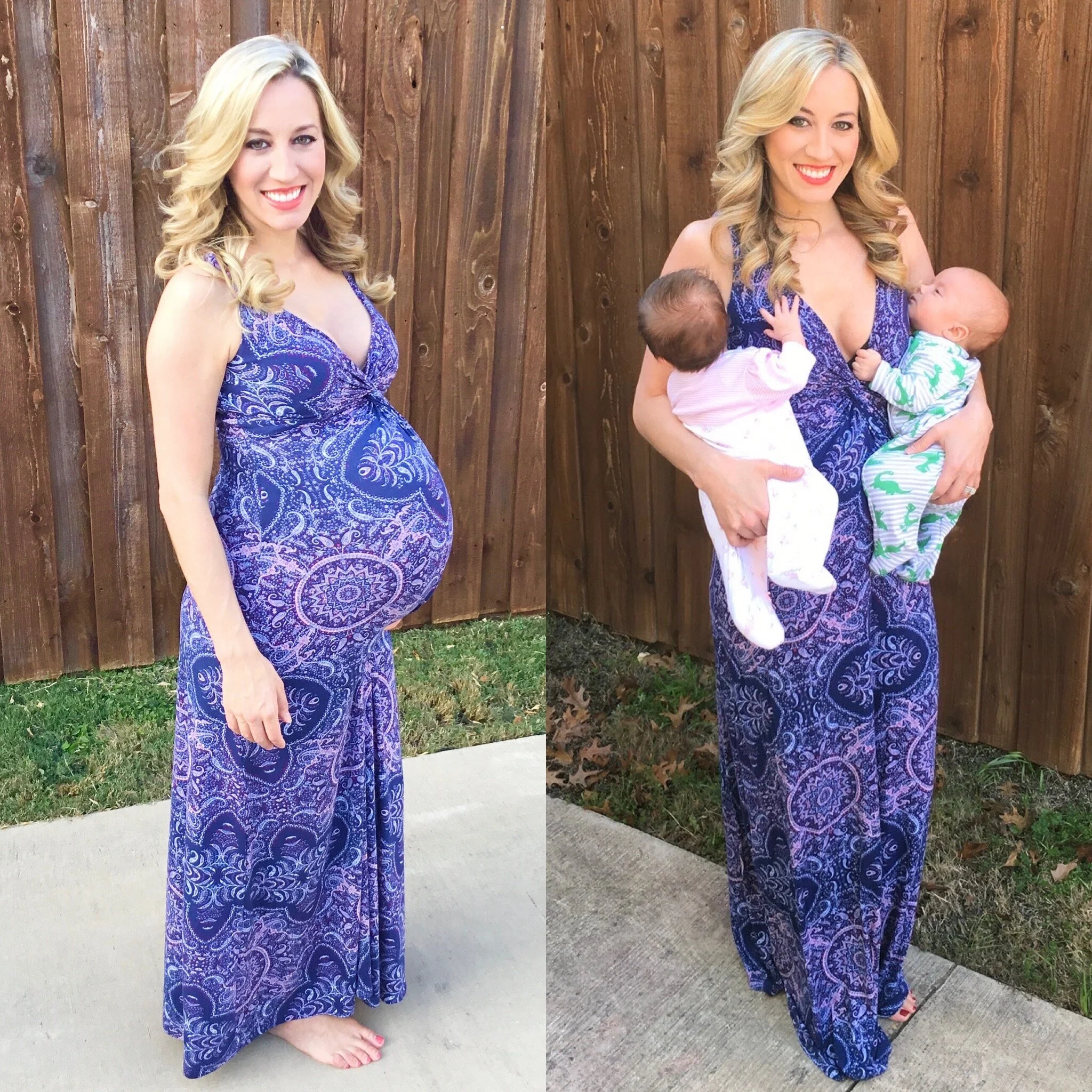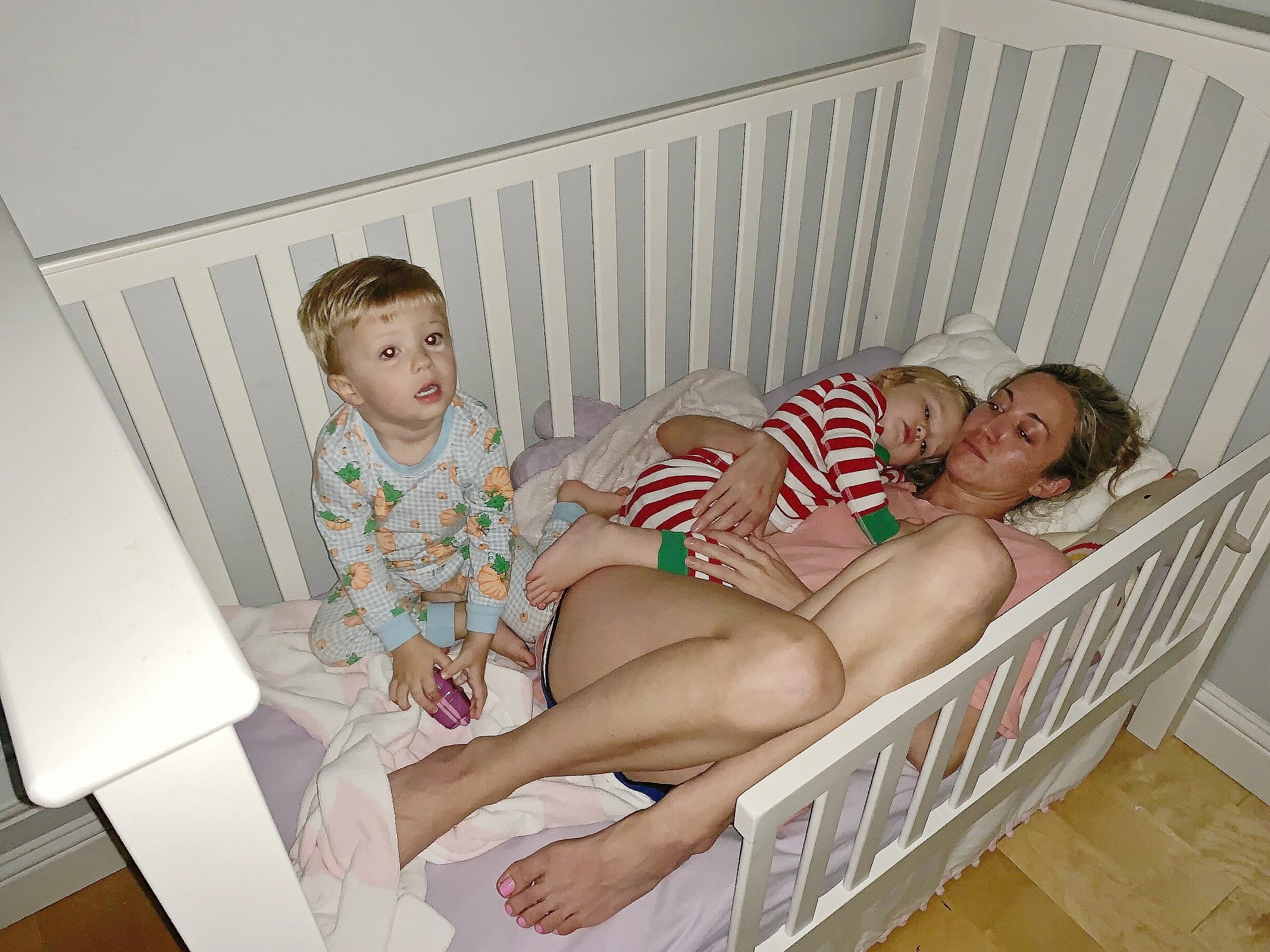How to Have a FASTER Postpartum Recovery
Spoiler alert: postpartum recovery is NOT an overnight sensation. No matter what you do, it requires 4 letters: T-I-M-E. However, the good news is that there are some things you can do to speed it up a little bit!
When I gave birth to my twins in 2017, I was ready to hit the ground running to get back to feeling normal—or at least close to it. I had gained 42 pounds during my twin pregnancy (which was a fabulous number for twins that I was proud of, by the way), but I was used to being 115-120 pounds. And with time, I got there again. I felt somewhat myself again by 3 months, I was back to my pre-pregnancy weight by 6 months, and I felt totally myself again by 9 months.
After bouncing back from my own twin pregnancy and learning some helpful strategies along the way, I now have 17 tips to share that can help YOU recover (maybe even a little faster!) during your postpartum period, too.
1. First and foremost, give yourself grace. You sincerely deserve it!
There will be various physical and emotional changes that are a natural part of the postpartum period. You will carry extra weight at first—but you can get it off over time. You might have some hair loss—but it will grow back. You might be sore in several places—but it’s only temporary. Just be kind to yourself. Don’t beat yourself up if it takes you a while to bounce back. They say patience is a virtue. And when it comes to postpartum recovery—oh boy, does that phrase apply! It takes 9 months to grow a baby, so it will take at least 9 months to get back to “normal.” I put normal in quotes because it will inevitably be a new normal—whether it be because of stretch marks, extra skin, or a different looking belly button after pregnancy. You just grew HUMANS so BE PROUD of yourself. Wear those beautiful changes as your badges of honor!
2. Balance PLENTY of rest with getting up and moving early on.
Of course your body needs rest in order to recover (and please do get plenty of it!). But, your body also needs to move in order to recover. When the nurses got me up and walking 12 hours after my C-section, I looked at them like they had 8 heads. It sounded ludicrous at the time because I was truly hurting and felt so tired. But, in retrospect, I know being pushed like that helped speed up my recovery process. Getting up and moving gets your blood flowing to all those areas that really need to heal, it keeps your intestines moving (no thanks, constipation!), and it keeps your lungs open (no thanks, pneumonia!). Just walking is a great place to start in those early weeks after delivery.
3. Pay attention to the restrictions your doctor gives you after delivering.
You don’t want to overdo it in the beginning because you don’t want to cause damage to your healing body. That will only postpone your recovery process. Depending on your route of delivery and other factors, your doctor will likely give you restrictions immediately after childbirth—such as no heavy lifting (no more than your baby’s weight), no stairs, no driving for 2 weeks, no exercise for 6 weeks, etc. Just pay attention to what your physician is telling you. I’ve heard horror stories of women’s C-section scars coming apart because they were doing too much those first several weeks—and you do NOT want to have to deal with that when you’re juggling newborn life.
4. Resume exercise when your doctor clears you (often at 6 weeks).
Usually there is a 6-week follow-up appointment with the OB-GYN at which time they will let you know if you’re “cleared” to resume your work out regimens. Of course it’s obvious that there are many perks to exercising after childbirth. It can help you lose weight, increase your energy, strengthen your muscles, decrease stress, improve sleep, and improve mental health. So, go for it!
5. Don’t ignore your aches and pains—ease them!
Along with the whole “get up and move early on” concept—you need to have your pain under control after delivery in order to be moving. Take the pain medications (as needed) that your doctor recommended for any incision site pain. Use heating pads for any uterine cramping. Take sitz baths to ease pain, promote healing, and prevent infection of any perineal tears. After my C-section, I found it was better to stay ahead of pain instead of behind it during that first postpartum week.
6. SLIM DOWN FASTER by wearing these 2 things that I swear by.
Whether you had a C-section or not, these are great for compression. I wore these ALL of the time for the first SEVERAL months. This special C-section underwear has a built in compression system that helps you feel less bloated, skinnier, supported, and also has a silicon strip inside at the level of the incision site that helps your scar heal faster. Once I got home, I always wore these under my abdominal binder. It made me feel somewhat normal again. I purchased a black and tan pair for myself (I mean, who wants to be doing laundry right after surgery?) While you’re still in the hospital they have special maternity underwear you use that helps with all of the heavy menstrual-like bleeding. However, I absolutely recommend buying at least 2 pairs of the C-Panties for when you're home. Oh, and the bleeding usually continues for the first 6 weeks postpartum, so you just have to add a maternity pad inside. You can purchase the C-panty for $39.95 (worth the splurge) here.
The hospital provided one, but I definitely recommend having a second one (because you’ll want to wear these every single day—no exaggeration) from the day you deliver until 5-6 weeks postpartum. That's what I did! After my C-section, I felt like all of my organs were hanging out and the only thing holding them together was a piece of skin (not muscle). The binder made me feel sturdy and supported, as if I had abdominal muscles to help me get up and move. It has 3 panels that allow you to bend and move but still remain compressed. That's why I wore it nonstop. You WILL want this—regardless of how you delivered. You can purchase one from Amazon for $13.99 here.
7. Keep things clean to avoid infection.
Rinse your C-section scar with soap and water (or however your doctor instructed you to clean), use perineal squeeze bottles when you use the bathroom, sit in a sitz bath if you had a tear or episiotomy, change postpartum pads regularly, etc. If you see any increased redness, tenderness, swelling, drainage, etc from any incision sites or stitches, then definitely call your doctor ASAP to ensure you don’t have an infection brewing.
8. Drink lots and lots of water.
I remember after I gave birth, ALL I wanted was cold ice water. I kept HUGE water jugs nearby at all times. Maintaining hydration is imperative given all of the fluid shifts your body goes through. It also prevents constipation, is great for your skin, and is key to successful breastfeeding!
9. Watch out for constipation.
Constipation is common after childbirth and can be exacerbated by episiotomy pain, C-section incision pain, and certain pain medications. Consider taking a stool softener, ensure you have plenty of fiber in your diet, keep moving/walking, and again, drink plenty of fluids!
10. Eat healthy and keep your protein intake high.
Even though you’re not pregnant anymore, your diet is just as important as it was during pregnancy! You want to be active, keep your energy levels up, and be able to take care of your baby/babies after delivery—and your diet will help you do that. Caring for newborns takes a lot of work! And don’t forget the importance of protein. The healing process is typically quickened by proper protein intake. So, keep those protein-rich foods nearby—such as eggs, chicken breast, beef, fish, cheese, almonds, milk, yogurt, etc. You can also consider a collagen protein drink to boost your intake. The one I drank was Protiva New Mom—which is a great collagen protein powder shake that’s specifically made for women in the postpartum phase that are looking to speed their recovery time and wound healing. It also boosts breastmilk production!
11. Continue to take your prenatal vitamin in the postpartum period, especially if you’re breastfeeding.
I certainly acknowledge that it can be VERY tough to ensure you’re eating a well-balanced diet when you’re exhausted, stressed out, and entirely consumed by taking care of little ones. In order to ensure you’re getting the necessary vitamins and minerals for you AND your baby (if you’re breastfeeding), it’s probably wise to continue your prenatal vitamin (or consider a postnatal vitamin) in the postpartum period. As a side note, it’s been said that continuing prenatal vitamins through the breastfeeding period can lead to better visual acuity, brain development, and skills processing in the infants.
12. Make sure you have a smart scale for tracking your weight-loss progress.
I’m a VERY visual person and I like objective data. So, personally, I like to see graphic trends over time. Numbers can be motivating, especially to women that want to be reassured that their postpartum efforts are paying off! The scale I use at home is the Fit Track Dara Smart Scale. It connects to an app on your phone and automatically measures and trends 17 different indicators for you (BMI, body fat %, muscle mass, body age, basal metabolic rate, protein rate %, etc.). Bonus feature: it also has an infant mode to weigh your baby, too!
13. Know that the oh-so-dreaded diastasis recti (aka abdominal muscle separation) is very common and there are ways to correct it.
Literally almost EVERY woman experiences some degree of diastasis recti during or after pregnancy—I mean, how could you not when your belly gets so big?! I used to have it, too. I gave birth to my twins in 2017 and I still have some residual separation, but it doesn’t quite meet the criteria for diastasis anymore as it’s healed over time. My separation is not very noticeable, unless I’m leaning backwards or trying to sit up from a lying down position.
It can be diagnosed by lying down flat with your knees bent, lifting your head off the ground, and having a separation between the abdominal muscles that’s the width of 2 fingertips or more. If you have it, then you might see some bulging between the muscles during certain movements. It’s typically more of a cosmetic issue and not usually dangerous. It’s most often seen in women that are small, carried multiples (twins, triplets, etc), have poor muscle tone, or have babies later in life.
I definitely do NOT pretend to be a work-out guru (it’s just never been my thing). But, I will tell you 2 things: 1) there are exercises that can IMPROVE the issue and 2) there are exercises that can WORSEN the issue that you should avoid (like crunches!). So, you want to be careful of what movements you’re doing. If diastasis recti workout regimens don’t help, then physical therapy is another option with cosmetic surgery being the last resort.
Read more about postpartum diastasis recti and 9 workouts that can help correct the issue here.
14. Keep a pulse on your mental health.
As I’m sure you’re very aware, baby blues and postpartum depression (PPD) are very real things that can happen—and they don’t discriminate! Due to such large hormonal changes after delivery, it can happen to any woman that’s just given birth. That said, check-in with yourself regularly and be mindful of where your mental health stands. Baby blues are totally normal and can last a few days to 2 weeks. If the symptoms last longer than 2 weeks, intensify, or are otherwise concerning, then it could be PPD and it warrants a call to your doctor. Either way, if it plagues you, DON’T feel ashamed! Confide in a family member or friend and just know that with the proper help, it’s 100% treatable. If you’re unsure of whether you might have the baby blues or PPD, then visit the American Pregnancy Association’s website for more information.
15. Schedule some time away from the kids.
I know it can be hard for some new moms to be apart from their little ones after giving birth—but it can’t hurt to have a moment to yourself. You’ve been looking after a baby for 9 months already! Whether it’s to sleep, just have some stress-free silence, go on a date with your spouse, run errands, get your nails done, see a movie, or whatever else brings you inner peace, just DO IT. Taking care of people starts with taking care of yourself. Don’t ever forget that! I remember about 2 weeks after I gave birth, I had the grandmas watch the twins and I went and got a mani/pedi. It was extremely relaxing and it was seriously the first time I had felt kind of normal in such a long time!
Photo by: Paige Walker Photography
16. Lean on your family and friends.
I’m just going to say this: ask for help when it’s needed and accept help when it’s offered. Plain and simple!
17. Keep all of your doctor’s appointments.
It’s very important to keep your doctor in the loop of your postpartum progress. If you’re worried about something related to your physical or emotional health, don’t let it go unchecked. The sooner any outstanding issues are addressed by your physician, the sooner you can recover from them.
As you’re recovering from your delivery, there are a few overarching points to keep in mind: Nobody’s postpartum journey will be the same and nobody’s journey will be perfect. Yours will be yours and mine will be mine. The one thing we can all do, though, is be patient with ourselves and give it time. If you’re in the “4th trimester” and/or just now jumping back into a workout routine and you’re feeling frustrated, hang in there. Don’t forget what amazing things you just accomplished. When people see you, they are going to be amazed by you—whether you’re back to your baseline or not—because you just created life!










